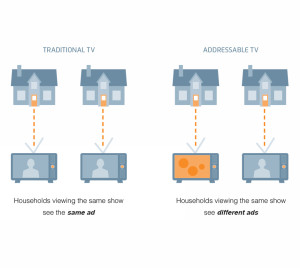Addressable TV Advertising
Addressable TV advertising technologies enable advertisers to selectively segment TV audiences and serve different ads or ad pods (groups of ads) within a common program or navigation screen. Segmentation can occur at geographic, demographic, behavioral and (in some cases) self-selected individual household levels, through cable, satellite and Internet Protocol television (IPTV) delivery systems and set-top boxes (STBs).[1]
How it Works[2]
Marketers pinpoint their target audiences and create a household profile using data such as income, ethnicity, children in the household and car leases set to expire. They then work with cable operators to determine the number of addressable-enabled households that fit their target and serve commercials to just those homes.

source: Live Ramp
Understanding Addressable TV Advertising[3]
- 1. Advertisers pay for audiences not content: The advertiser defines the audience it wants to target and pays for impressions regardless of what content that audience is watching at the time. Addressable TV chiefly refers to ads targeted at specific household audiences watching linear television. Currently, the number of addressable households stands at around 50m in the US (essentially those that have a set-top box and for whom census-level data is available).Census data allows for targeting based on income, ethnicity, children and even car leases. Of course, there is are addressable media available in TV and video. Video-on-demand (VoD), smart TVs and over-the-top (OTT) services allowing for programmatic ad buying and can offer more specific targeting (particularly on personal devices).
- 2. Addressable ads make TV accessible for more niche advertisers: Being able to buy fewer but much more targeted impressions helps more niche advertisers. Though addressable TV is more expensive per 'impression', there is inherently less wastage. A common example cited is the example of an advertiser targeting home renters - something that would be too wasteful if done with traditional broadcast advertising.
- 3. Uptake is pretty modest: According to eMarketer, addressable TV spend in 2015 was $400m in the US. In 2016 that will reach $890m, topping $2bn by the end of 2018. Sounds healthy enough, but for 2016 that's only 1.3% of total TV ad spend in the US. Some of the main providers offering addressable TV ads include Cablevision, Comcast, DirecTV and Dish.
- 4. Creative versioning has not yet taken off: Though providers such as Cablevision do offer the technology, advertisers are not yet versioning creative for addressable TV like they do with programmatic display ads. This isn't entirely surprising, given the nascency of the technology but it will prove an interesting talking point in the next few years. Will TV ads benefit from one-to-one dynamic content? Can re-targeting (of a sort) be done creatively on the family set? One might suggest such impressive but rather functional targeting has been partly responsible for a malaise in online advertising.
- 5. Lack of standardization makes for more work: Different operators use different technologies and so it can be time consuming to run and report on ads across a number of them.
- 6. Controlling ad frequency becomes possible: Addressable TV means that advertisers can measure and optimize the number of impressions a given person or household is exposed to. In theory this will allow advertisers to experiment and better understand optimum exposure. Ads can be changed or stopped when the audience hits a particular threshold. Of course, as online advertising shows, this isn't always the case in practice. TVs are rarely personal devices and we all make a cup of tea now and again. However, what's clear is that where some are advertisers are still concerned about ad fraud and viewability online, TV (both linear and on-demand) maintains a reputation for quality and transparency that advertisers love. The question is one of scaling addressable TV and making it work for all.
References
External References
- Addressable TV Advertising: Creating a Better, More Personal TV and Video Experience Think with Google
- How Addressable TV Has Evolved, And Where It Will Go In 2017 Ad Exchanger
- Study Projects Addressable TV Advertising Will Double by 2018 AdWeek
- Addressable TV: Cutting the Waste Out of Your TV Advertising Eyeview
